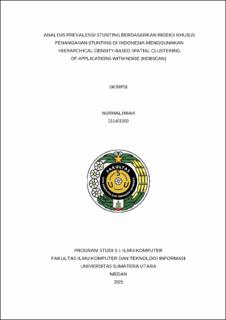Analisis Prevalensi Stunting Berdasarkan Indeks Khusus Penanganan Stunting di Indonesia Menggunakan Hierarchical Density-based Spatial Clustering of Applications With Noise (HDBSCAN)
Analysis of Stunting Prevalence Based on the Special Stunting Handling Index in Indonesia Using Hierarchical Density-Based Spatial Clustering Of Applications With Noise (HDBSCAN)

Date
2025Author
Nurhalimah, Nurhalimah
Advisor(s)
Hayatunnufus
Nababan, Anandhini Medianty
Metadata
Show full item recordAbstract
Stunting is a serious health problem that can affect children's physical growth and cognitive development. This study aims to classify districts/cities in Indonesia based on stunting indicators using the HDBSCAN algorithm. The data used includes stunting prevalence and the Special Stunting Handling Index (IKPS) for three years, namely 2020 (190 districts/cities), 2021 (315 districts/cities) and 2022 (469 districts/cities). The clustering results show that each year 3 clusters are formed with different characteristics. In 2020, Cluster 1 had 5 districts/municipalities (Good Prevalence, Optimal IKPS), Cluster 0 had 73 districts/municipalities (Medium Prevalence, Stable IKPS) and Cluster 2 had 112 districts/municipalities (Poor Prevalence, Low IKPS). In 2021, Cluster 1 had 61 districts/cities (Intermediate Prevalence, Optimal IKPS), Cluster 2 had 246 districts/cities (Poor Prevalence, Stable IKPS), Cluster 0 had 8 districts/cities (Good Prevalence, Low IKPS). In 2022, Cluster 0 had 198 districts/municipalities (Intermediate Prevalence, Optimal IKPS), Cluster 2 had 264 districts/municipalities (Poor Prevalence, Stable IKPS), Cluster 1 had 7 districts/municipalities (Good Prevalence, Low IKPS). Cluster evaluation using the Davies-Bouldin Index (DBI) showed that the quality of clustering was good with DBI values of 0.5827 in 2020, 0.6639 in 2021, and 0.5710 in 2022. Priority year external testing results are dominated by Cluster 2 for each year and are appropriate overall. The interactive dasbor developed in this study visualizes the clustering results, including area mapping, comparison of prevalence and IKPS, and ranking of priority areas. This visualization is expected to provide a picture of areas with stunting prevalence and indicators that need to be improved.
Collections
- Undergraduate Theses [1253]
